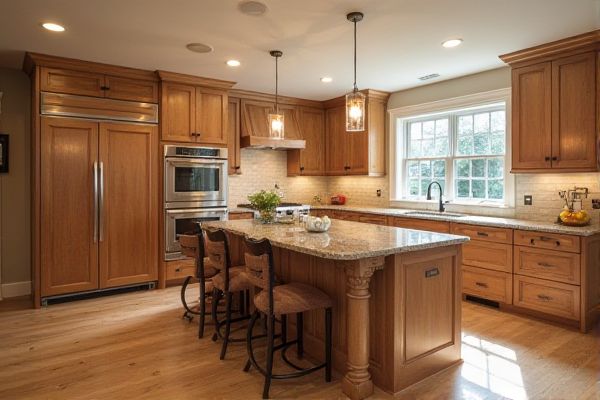
Choosing between horizontal grain and vertical grain cabinetry influences the visual flow and perceived texture of your kitchen design; horizontal grain can emphasize width and create a modern, expansive look while vertical grain adds height and traditional elegance. Discover how these grain orientations impact durability, style, and installation to make the best choice for your cabinetry project.
Table of Comparison
| Feature | Horizontal Grain Cabinetry | Vertical Grain Cabinetry |
|---|---|---|
| Appearance | Grain runs along cabinet width; modern and sleek look | Grain runs along cabinet height; traditional and classic look |
| Durability | Less prone to warping in wider panels | Better stability on taller door panels |
| Design Suitability | Ideal for contemporary, minimalist kitchens | Perfect for farmhouse, rustic, or classic styles |
| Maintenance | Easier to clean due to visible grain direction | May show dirt streaks along grain; requires regular cleaning |
| Cost | Typically cost-effective due to efficient wood usage | May be slightly more expensive for taller panels |
Introduction to Wood Grain Orientation in Cabinetry
Wood grain orientation in cabinetry significantly affects durability, aesthetic appeal, and finishing processes. Horizontal grain typically showcases wider, more uniform patterns ideal for contemporary designs, while vertical grain reveals natural growth rings that enhance traditional, rustic appearances. Understanding the wood grain direction informs construction choices, impacting cabinet strength and resistance to warping over time.
What is Horizontal Grain Cabinetry?
Horizontal grain cabinetry features wood grain patterns running parallel to the cabinet face, creating a sleek, contemporary look that highlights the natural flow of the wood. This design enhances the visual width of cabinets and emphasizes modern, linear aesthetics, often preferred in minimalist and Scandinavian styles. You can achieve a unique, refined appearance by choosing horizontal grain cabinetry, which also tends to showcase wood textures and patterns more prominently than vertical grain options.
What is Vertical Grain Cabinetry?
Vertical grain cabinetry features wood boards with growth rings aligned vertically, resulting in a straight, uniform grain pattern that enhances the cabinet's durability and stability. This wood orientation reduces warping and shrinking, making vertical grain an ideal choice for long-lasting, high-quality cabinetry in kitchens and bathrooms. Your cabinets will benefit from the consistent appearance and improved structural integrity that vertical grain wood provides.
Aesthetic Differences Between Horizontal and Vertical Grains
Horizontal grain cabinetry creates a sleek, modern aesthetic with a sense of width and openness, emphasizing the natural flow of wood patterns along the length of cabinet doors. Vertical grain cabinetry offers a classic, tall, and structured look that enhances perceived height and adds formal elegance to kitchen or bathroom designs. Grain orientation significantly influences visual texture and style, shaping the overall ambiance and spatial perception of cabinetry.
Durability and Structural Integrity
Horizontal grain cabinetry often exhibits increased resistance to warping due to the wood fibers running parallel to the cabinet face, enhancing durability in varying humidity conditions. Vertical grain cabinetry offers superior structural integrity by aligning the wood fibers vertically, which supports better load distribution and reduces the risk of splitting over time. Both grain orientations provide distinct advantages; horizontal grains improve stability in wider panels while vertical grains ensure strength in taller cabinet doors.
Impact on Room Size Perception
Horizontal grain cabinetry visually expands a room by drawing the eye along the length of the cabinets, creating an illusion of wider space. Vertical grain cabinets emphasize height, making ceilings appear taller and the area more spacious vertically. You can choose grain direction based on whether you want to enhance the room's width or height for optimal size perception.
Maintenance and Cleaning Considerations
Horizontal grain cabinetry generally requires more frequent cleaning to prevent dust and grease buildup in the visible grooves, while vertical grain surfaces tend to hide dirt better due to their natural texture alignment. Vertical grain wood is less prone to warping and swelling, making it easier to maintain in humid or variable environments, reducing long-term maintenance efforts. Choosing cabinetry with vertical grain can enhance durability and simplify cleaning routines, ensuring a consistently clean appearance with minimal upkeep.
Best Applications for Horizontal Grain Cabinetry
Horizontal grain cabinetry excels in modern and contemporary kitchen designs due to its clean, streamlined appearance that enhances the perception of space. It is ideal for wider cabinet fronts where the grain pattern can be showcased continuously, creating a sleek and cohesive look. This style is particularly effective in open-concept layouts and minimalist interiors, emphasizing horizontal lines for a sophisticated aesthetic.
Best Applications for Vertical Grain Cabinetry
Vertical grain cabinetry offers superior strength and durability due to the alignment of wood fibers, making it ideal for high-traffic areas such as kitchens and bathrooms. This grain orientation minimizes warping and shrinkage, ensuring long-lasting performance in cabinetry exposed to moisture and temperature fluctuations. Vertical grain wood also provides a clean, linear aesthetic that complements modern and traditional interior designs, enhancing both function and style in cabinetry applications.
Choosing the Right Grain Orientation for Your Space
Choosing the right grain orientation for your cabinetry impacts both aesthetics and durability, with horizontal grain offering a modern, expansive look that highlights length, while vertical grain emphasizes height and traditional elegance. Horizontal grain can make your space feel wider, ideal for contemporary kitchens, whereas vertical grain directs the eye upward, enhancing room height and adding a classic touch. Consider your room's dimensions and style to select the grain orientation that best complements your cabinetry and overall design goals.
 homyna.com
homyna.com